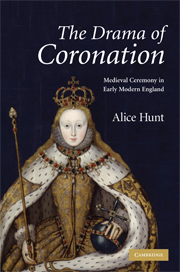Book contents
- Frontmatter
- Contents
- Preface
- Note on style and dates
- List of abbreviations
- Introduction: the ‘idol’ ceremony of coronation
- Chapter 1 Why crown a king? Henry VIII and the medieval coronation
- Chapter 2 ‘Come my love thou shalbe crowned’: the drama of Anne Boleyn's coronation
- Chapter 3 ‘But a ceremony’: Edward VI's reformed coronation and John Bale's King Johan
- Chapter 4 ‘He hath sent Marye our soveraigne and Quene’: England's first queen and Respublica
- Chapter 5 ‘A stage wherin was shewed the wonderfull spectacle’: representing Elizabeth I's coronation
- Epilogue: ‘Presume not that I am the thing I was’
- Notes
- Bibliography
- Index
Chapter 1 - Why crown a king? Henry VIII and the medieval coronation
Published online by Cambridge University Press: 22 September 2009
- Frontmatter
- Contents
- Preface
- Note on style and dates
- List of abbreviations
- Introduction: the ‘idol’ ceremony of coronation
- Chapter 1 Why crown a king? Henry VIII and the medieval coronation
- Chapter 2 ‘Come my love thou shalbe crowned’: the drama of Anne Boleyn's coronation
- Chapter 3 ‘But a ceremony’: Edward VI's reformed coronation and John Bale's King Johan
- Chapter 4 ‘He hath sent Marye our soveraigne and Quene’: England's first queen and Respublica
- Chapter 5 ‘A stage wherin was shewed the wonderfull spectacle’: representing Elizabeth I's coronation
- Epilogue: ‘Presume not that I am the thing I was’
- Notes
- Bibliography
- Index
Summary
In 1838, during a debate about Victoria's forthcoming coronation, Earl Fitzwilliam declared that ‘coronations were fit only for barbarous, or semi-barbarous ages; for periods when crowns were won and lost by unruly violence and ferocious contests’. Fitzwilliam's contention was that when a monarch's legitimacy is not in doubt, and he or she earns the English crown through divine right alone, there is simply no point to a coronation. But the ‘semi-barbarous’ ages to which he refers were long gone, and yet the coronation continued during the medieval period, unruly deposition or peaceful succession notwithstanding. Henry VII won his crown on Bosworth Field but the legitimacy of his second son and heir, Henry VIII, was not in doubt and both Henrys were crowned according to the ‘usual ceremonies’, as the Venetian ambassador described of Henry VIII's coronation in June 1509. The survival of the coronation ceremony in England is a unique story. As Paul Kléber Monod points out, only the French coronation can compare in its claims for the sacred body and the healing powers of the anointed king. Despite its Frankish origins and shared characteristics with Byzantine imperial crownings in imitation of ancient Rome, the coronation throughout Europe fulfilled different cultural roles which were not necessarily indicators of how sacred the office of monarchy was held to be, suggesting instead divergent attitudes towards the function of the ceremony.
- Type
- Chapter
- Information
- The Drama of CoronationMedieval Ceremony in Early Modern England, pp. 12 - 38Publisher: Cambridge University PressPrint publication year: 2008

